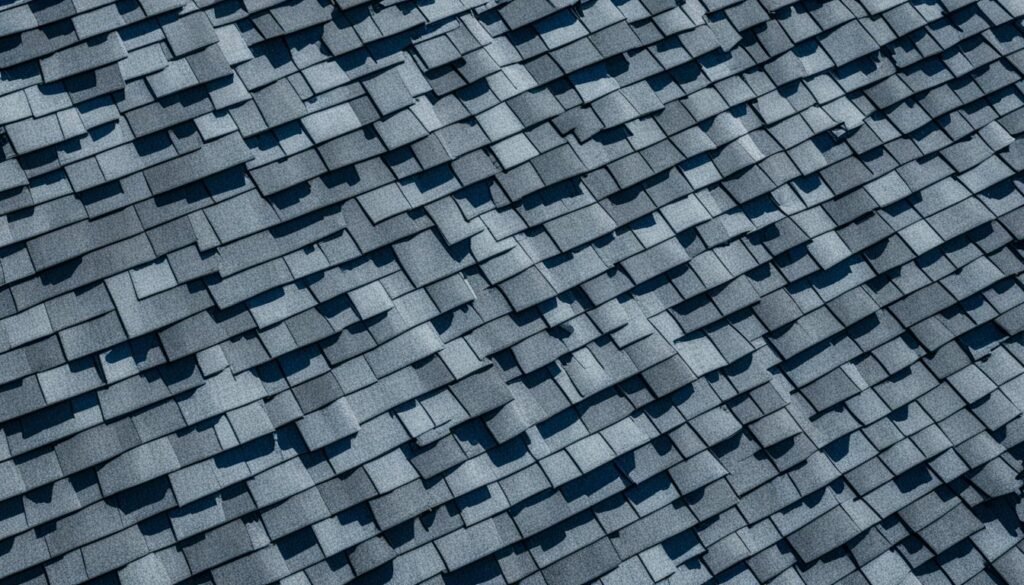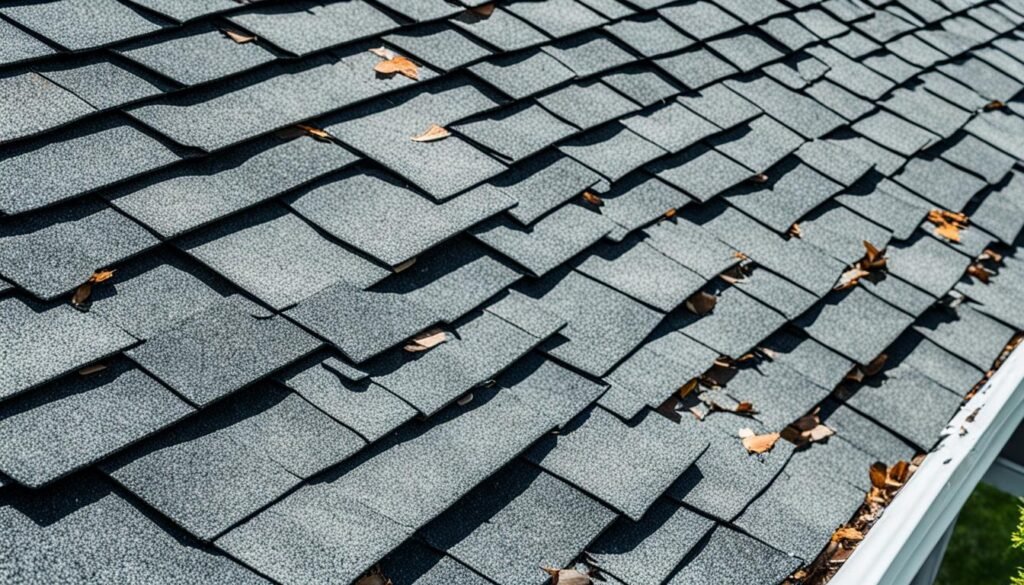Roof leaks can cause big trouble like mold and damaged ceilings. It’s key to know the weak spots of your roof. This helps keep your home safe and strong. Learning about these areas lets you make smart moves. You can make your roof last longer and dodge high repair bills.
Finding the weak parts of your roof is the first vital step. It makes your roof work better and helps avoid problems. Things like flashings, sealants, gutters, and shingles are important for your roof’s health. Fixing these weak links protects your home and keeps it strong for years.
Key Takeaways
- Roof leaks can cause serious damage, such as mold and rotted framing.
- Knowing the roof’s weakest areas helps it last longer and avoids expensive fixes.
- Understanding each part of your roof, like flashings and gutters, is vital for your home’s strength.
- Regular checks and care stop small problems from becoming big ones.
- Always have a pro do your roof repairs to keep your home safe and sound.
Vulnerable Areas on Your Roof
Some parts of your roof are weaker than others. It’s good to know where problems can happen. This way, you can keep your roof strong for a long time. You’ll also protect it from bad weather.
Flashings and Sealants
Flashings are strips that seal the edges of things like vents and chimneys. They keep water out. But, they can wear down over time. This happens because of the weather and rust. It’s very important to check them often to stop water from getting inside.
Fascia and Soffit
Fascia is the board that goes around your roof. It can get damaged by the weather. Soffit is under the roof’s edge. If not checked, it can start to decay. Keeping fascia and soffit in good shape helps protect your roof.
It’s key to look after weak spots on your roof. Regular checks and fixing small issues can prevent big problems. Working with skilled roofers helps catch issues early. This means you avoid expensive repairs later on.

Weakest Part of Roof: Gutters and Shingles
Gutters and shingles are often the weakest parts of your roof. Gutters protect your home from water damage but can catch debris. This debris leads to mildew, mold, and sagging. Shingles, the roof’s outer layer, can fade, curl, and get damaged by weather.
Keeping your gutters and shingles in check stops leaks and protects your roof’s strength. Flashing at roof joints can wear out, causing leaks. The fascia, a board at the roof’s edge, might also weaken. This can make your roof sag or even collapse.
In Arizona, roofs suffer more during the monsoon season. Homes without gutters are at serious risk of water damage. The state’s roofs made of clay or asphalt shingles can be damaged by the sun and wind.
Working with skilled roofers is key to roof maintenance. The pros can spot and fix gutter and shingle problems early. This protects your home from weather and keeps your roof strong.
| Roof Component | Common Issues | Potential Consequences |
|---|---|---|
| Gutters | Debris buildup, deterioration | Mildew, mold, sagging |
| Shingles | Fading, curling, damage from high winds, fallen objects, heavy rain | Leaks, structural issues |
| Flashing | Deterioration around roof joints | Leaks, other problems |
| Fascia | Deterioration over time | Roof sagging or collapse |
Focusing on your roof’s weak spots is vital for long-term home protection. Skilled local roofers can find and fix these issues. This keeps your gutters, shingles, and roof strong.

Roof Ridges, Valleys, and Eaves
Roofing often focuses on the big parts but misses the bottom line: ridges, valleys, and eaves. Yet, these spots can easily get damaged, causing leaks and costly repairs if neglected.
The roof ridge is where two parts of the roof meet. It’s a weak area because shingles can miss spots. This lets water in. It’s key to use the right flashing and sealants to protect this spot.
The roof valleys are lower areas between roof slopes. They guide water down and can cause leaks. Good flashing and sealants prevent this. Routine checks keep these parts healthy.
Now, eaves are about the part of the roof that sticks out. They can break from too much junk or not enough support. Ensuring they’re clean and ventilated prevents problems.
Knowing what parts need more attention is crucial for homeowners. Acting ahead helps avoid big repairs. Local roof pros can do checks to spot issues early.
| Roof Component | Potential Weakness | Recommended Action |
|---|---|---|
| Roof Ridge | Incomplete shingle coverage, exposing roof structure | Proper flashing and sealants to ensure integrity |
| Roof Valleys | Water convergence and increased risk of leaks | Regular inspections and maintenance of flashing and sealants |
| Roof Eaves | Debris accumulation and limited weight-bearing capacity | Keep eaves clear of debris and ensure proper ventilation |
Addressing these challenges improves the roof’s durability. This keeps the home safe for a long time. Experienced roof pros are essential for finding and fixing any problems.
Conclusion
Identifying the weakest parts of your roof is key to home protection. It makes sure your home stays strong and safe. Keeping an eye on parts like flashings, sealant, and gutters avoids big costs later on.
Working with experts such as Local Roofer Pros is a smart move. They help keep your home safe from roof weaknesses and dangerous structures. With the right care, your roof can be made stronger and last longer.
Deal with small roof problems quickly to avoid big troubles in the future. Stay alert and handle the weakest parts of your roof fast. This ensures your home’s roof remains safe and intact for years to come.
FAQ
What are the weakest parts of a roof?
Why is it important to identify the weakest parts of a roof?
How can I maintain the flashings and sealants on my roof?
What is the importance of the fascia and soffit on a roof?
How can I maintain the gutters and shingles on my roof?
What are the vulnerable areas of the roof ridge, valleys, and eaves?
Source Links
- https://www.familyhandyman.com/list/silent-signs-you-have-a-damaged-roof/
- https://www.patriotroofing.com/blog/2022/01/25/common-weak-points-in-your-roof/
- https://mcclellandsroofing.com/blogs/flat-roofs-and-low-slope-roof/
- https://bonedry.com/punta-gorda/a-roofs-common-weak-points/
- https://www.summitroofingandrestoration.com/atoka/blog/roof-vulnerable-parts-and-how-to-maintain-them/
- https://www.dougashy.com/post/the-4-most-vulnerable-areas-of-your-home-during-a-hurricane
- https://helmuthroofing.com/roof-weak-spots/
- https://rosieonthehouse.com/blog/the-weakest-parts-of-your-roof/
- https://bonedry.com/sarasota/a-roofs-common-weak-points/
- https://www.bravarooftile.com/blog/important-parts-of-a-roof/
- https://allpointstile.com/what-are-the-different-parts-of-a-roof-called/
- https://joylandroofing.com/vulnerable-parts-roof-residential/
- https://ridgelineconstructionhsv.com/common-roofing-areas-where-leaks-occur-most-often
- https://buildingrepair.my/common-roofing-defects-and-ways-to-prevent-them
- https://www.roofingcompanybristolltd.co.uk/common-pitched-roof-problems
